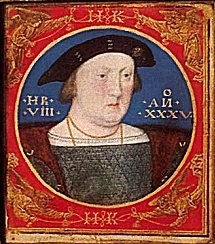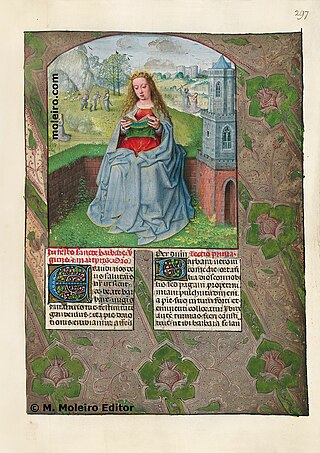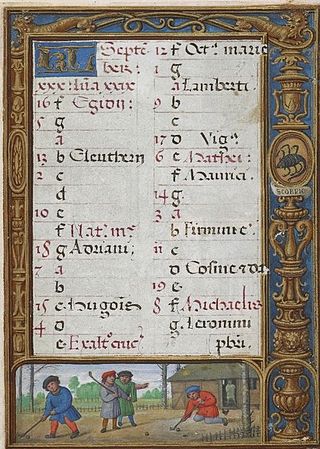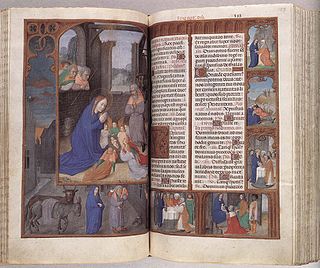
The Hours of Joanna I of Castile is a sixteenth-century illuminated codex housed in the British Library, London, under call number Add MS 35313.

The Hours of Joanna I of Castile is a sixteenth-century illuminated codex housed in the British Library, London, under call number Add MS 35313.
The miniatures are the work of Gerard Horenbout, the greatest Flemish miniaturist of the 16th century, and Sanders Bening and his workshop, who painted most of the portraits in the Suffrages of the Saints. The authorship of these two ateliers suggests that the manuscript was made in the city of Ghent.
Gerard Horenbout and his atelier painted 38 of the manuscript’s miniatures and possibly the calendar too. Horenbout is the surname of a family of artists from Ghent from the 15th – 17th centuries. Gerard was admitted to the Ghent painters’ guild as a master in 1487 and in 1515 was appointed court painter and valet to Margaret of Austria. Bering and his atelier produced another 37 miniatures including 24 half-page illuminations. Although little documentary evidence about his work has survived, he is known to have been admitted to the SS. Luke and John Painters’ and Sculptors’ Guild of Ghent in 1463, and that he lived in Ghent and visited Bruges regularly to sell his paintings.

Noteworthy features of these miniatures are their three-dimensional realism and great sophistication, particularly those in the Passion cycle. The faces charged with emotion and the lively realism of the illuminated scenes make this manuscript one of the most outstanding works of Flemish art.
The layout of the calendar pages in the Hours of Joanna I of Castile consists of a series of images around the text of each month, where the letters KL (calendas) can be seen (as in most medieval manuscript calendars) and also a set of columns of numbers, letters and text. This calendar highlights important feasts by writing the saint’s name in red ink and minor feasts in black. Each folio in the calendar shows one month and features the architectural frame and medallions typical of the Ghent-Bruges school. Depicted along the bottom, as usual in books of hours, is an activity typical of the month in question.

The most innovative parts of the manuscript are lavishly illuminated and found in two different iconographic cycles: the Hours of the Cross and the Hours of the Virgin. The Hours of the Cross contain fourteen miniatures arranged in pairs which depict the Passion of Christ from the entrance into Jerusalem to the holy burial. The Hours of the Virgin contain eight pairs of miniatures, most of which feature an episode from Our Lady’s life from the Annunciation to the Crowning, together with the occasional related episode from the Old Testament. The manuscript’s finest miniatures are to be found in these two cycles, in which the artist reduces the text inserts to a minimum, sometimes just two lines, to leave as much room as possible for the illumination. The uniform style of the margins helps give these insertions a seamless, visual continuity.
The Office of the Dead features a version of a rather unusual composition to be found in the Hours of Mary of Burgundy, Berlin showing Mary on horseback in the legend of the three living and three dead creatures. This miniature may well suggest that that book was commissioned for a woman or for someone closely related to the Duchess of Burgundy.
The lavishness of the manuscript indicates that it was commissioned by a monarch. The presence of St Celedonius, St Ildephonsus and St Isidore suggest that the codex was made for a member of Spanish royalty, possibly Joanna the Mad, Queen of Castile, judging by the references to St John the Baptist, St John the Evangelist and St Isidore.
In the mid-nineteenth century, the codex belonged to the collection of Ferdinand James Anselm de Rothschild (1839–1898), Baron de Rothschild, whose family also owned the Rothschild Prayerbook , which was also painted by Gerard Horenbout. The Baron bequeathed the Hours of Joanna I of Castile to the British Museum in 1898.
The Spanish publisher M. Moleiro Editor published the first and only facsimile edition of the Hours of Joanna I of Castile in a limited edition of 987 with a companion volume featuring studies by Carlos Miranda García-Tejedor.

Gerard David was an Early Netherlandish painter and manuscript illuminator known for his brilliant use of color. Only a bare outline of his life survives, although some facts are known. He may have been the Meester gheraet van brugghe who became a master of the Antwerp guild in 1515. He was very successful in his lifetime and probably ran two workshops, in Antwerp and Bruges. Like many painters of his period, his reputation diminished in the 17th century until he was rediscovered in the 19th century.

Simon Bening was a Flemish miniaturist, generally regarded as the last major artist of the Netherlandish tradition.

Louis de Bruges, Lord of Gruuthuse, Prince of Steenhuijs, Earl of Winchester, was a Flemish courtier, bibliophile, soldier and nobleman. He was awarded the title of Earl of Winchester by King Edward IV of England in 1472, and was Stadtholder of Holland and Zeeland 1462–77.

Simon Marmion was a French and Burgundian Early Netherlandish painter of panels and illuminated manuscripts. Marmion lived and worked in what is now France but for most of his lifetime was part of the Duchy of Burgundy in the Southern Netherlands.

Lucas Horenbout, often called Hornebolte in England, was a Flemish artist who moved to England in the mid-1520s and worked there as "King's Painter" and court miniaturist to King Henry VIII from 1525 until his death. He was trained in the final phase of Netherlandish illuminated manuscript painting, in which his father Gerard was an important figure, and was the founding painter of the long and distinct English tradition of portrait miniature painting. He has been suggested as the Master of the Cast Shadow Workshop, who produced royal portraits on panel in the 1520s or 1530s.

The Master of Anthony of Burgundy was a Flemish miniature painter active in Bruges between about 1460 and 1490, apparently running a large workshop, and producing some of the most sophisticated work of the final flowering of Flemish illumination. He was first identified by Winkler in 1921; his name is derived from one of his most elevated patrons, Anthony of Burgundy, Philip the Good's illegitimate son, though he also worked for the Dukes and other bibliophiles in Burgundian court circles, who had already been allocated "Masters" by art historians. His contributions to the heavily illustrated Froissart of Louis of Gruuthuse from the early 1470s, on which several of the leading illuminators of the day worked, show him excelling some more famous names, like Loiset Lyédet. The young Master of the Dresden Prayerbook worked as his assistant on this book, suggesting he was an apprentice; a number of other anonymous masters have been postulated as his pupils. Other works are in the libraries of Paris, Wrocław, Philadelphia, Munich, Cambridge University Library and elsewhere.

The Master of James IV of Scotland was a Flemish manuscript illuminator and painter most likely based in Ghent, or perhaps Bruges. Circumstantial evidence, including several larger panel paintings, indicates that he may be identical with Gerard Horenbout. He was the leading illuminator of the penultimate generation of Flemish illuminators. The painter's name is derived from a portrait of James IV of Scotland which, together with one of his Queen Margaret Tudor, is in the Prayer book of James IV and Queen Margaret, a book of hours commissioned by James and now in Vienna. He has been called one of the finest illuminators active in Flanders around 1500, and contributed to many lavish and important books besides directing an active studio of his own.

The Turin–Milan Hours is a partially destroyed illuminated manuscript, which despite its name is not strictly a book of hours. It is of exceptional quality and importance, with a very complicated history both during and after its production. It contains several miniatures of about 1420 attributed to an artist known as "Hand G" who was probably either Jan van Eyck, his brother Hubert van Eyck, or an artist very closely associated with them. About a decade or so later Barthélemy d'Eyck may have worked on some miniatures. Of the several portions of the book, that kept in Turin was destroyed in a fire in 1904, though black-and-white photographs exist.

The Rothschild Prayerbook or Rothschild Hours, is an important Flemish illuminated manuscript book of hours, compiled c. 1500–1520 by a number of artists.
M. Moleiro Editor is a publishing house specialising in high-quality facsimile reproductions of codices, maps and illuminated manuscripts. Founded in Barcelona in 1991, the firm has reproduced many masterpieces from the history of illumination.

The Isabella Breviary is a late 15th-century illuminated manuscript housed in the British Library, London. Queen Isabella I of Castile was given the manuscript shortly before 1497 by her ambassador Francisco de Rojas to commemorate the double marriage of her children and the children of Emperor Maximilian of Austria and Duchess Mary of Burgundy.

The Hours of James IV of Scotland, Prayer book of James IV and Queen Margaret is an illuminated book of hours, produced in 1503 or later, probably in Ghent. It marks a highpoint of the late 15th century Ghent-Bruges school of illumination and is now in the Austrian National Library in Vienna. It is thought to have been a wedding gift from James IV of Scotland or another Scottish nobleman to James's wife Margaret Tudor on the occasion of their marriage, perhaps finishing a book already started for another purpose. A number of artists worked on the extensive programme of decoration, so that "the manuscript in its entirety presents a rather odd picture of heterogeneity". The best known miniature, a full-page portrait of James at prayer before an altar with an altarpiece of Christ and an altar frontal with James's coat-of-arms, gave his name to the Master of James IV of Scotland, who is now generally identified as Gerard Horenbout, court painter to Margaret of Austria; he did only one other miniature in the book. The equivalent image of Margaret is the only image by another artist, using a rather generic face for the queen's portrait, and in a similar style to that of the Master of the First Prayer Book of Maximilian. Other artists worked on the other miniatures, which include an unusual series of unpopulated landscapes in the calendar – perhaps the Flemish artists were not sure how Scots should be dressed.

The Hours of Mary of Burgundy is a book of hours, a form of devotional book for lay-people, completed in Flanders around 1477, and now in the National Library of Austria. It was probably commissioned for Mary, the ruler of the Burgundian Netherlands and then the wealthiest woman in Europe. No records survive as to its commission. The book contains 187 folios, each measuring 225 by 150 millimetres. It consists of the Roman Liturgy of the Hours, 24 calendar roundels, 20 full-page miniatures and 16 quarter-page format illustrations. Its production began c. 1470, and includes miniatures by several artists, of which the foremost was the unidentified but influential illuminator known as the Master of Mary of Burgundy, who provides the book with its most meticulously detailed illustrations and borders. Other miniatures, considered of an older tradition, were contributed by Simon Marmion, Willem Vrelant and Lieven van Lathem. The majority of the calligraphy is attributed to Nicolas Spierinc, with whom the Master collaborated on other works and who may also have provided a number of illustrations.

The Sforza Hours, is a richly illuminated book of hours initiated by Bona Sforza, widow of Galeazzo Sforza, Duke of Milan, around 1490, who commissioned the illuminator Giovanni Pietro Birago. The book remained in an unfinished state for 30 years until Margaret of Austria, Regent of the Netherlands, commissioned its completion in 1517–20 from the artist Gerard Horenbout. The book therefore contains decoration of the highest quality by two artists. It provides a unique example of an early sixteenth-century Northern Renaissance illuminator's response to Milanese art of the late Quattrocento. The history of the Sforza Hours also includes one of the earliest recorded examples of art theft.

The Ghent-Bruges school is a distinctive style of manuscript illumination which was prevalent in the Southern Netherlands from about 1475 to about 1550. Though the name highlights the importance of Ghent and Bruges as centres for manuscript production, manuscripts in the style were produced in a wider area.

The Golf Book is the common name for an illuminated manuscript Book of Hours in the Use of Rome dating from the 1540s. Only 23 pages remain of the original created by the illuminator Simon Bening and his studio in Bruges. It owes its popular name to one illustration in the calendar, with people playing a game resembling that of golf. It is presumed to have been made for a Swiss patron as the book includes a miniature painting of St Boniface of Lausanne.

The Spinola Book of Hours is a sixteenth-century illuminated manuscript, consisting of 310 folios with 84 fully illustrated miniature paintings. This medieval manuscript was produced in the region between Bruges and Ghent in Flanders around 1510-1520. According to Thomas Kren, a former curator of the J. Paul Getty Museum, the artwork within the Spinola Hours can be attributed to five distinct artists. Forty-seven of these illuminated pages can be accredited to the 'Master of James IV'. The Spinola Hours bears a central coat-of-arms on the cover indicating it belonged to the Spinola family of Genoa. Today it is located at the J. Paul Getty Museum in Los Angeles.

The Breviary of Eleanor of Portugal is an early 16th-century Flemish illuminated manuscript Breviary, providing the divine office according to the Roman ordinal and calendar.

The Master of Margaret of York is the Notname of an illuminator active in Bruges between 1470 and 1480. He owes his name to a devotional book he decorated for Margaret of York, wife of Charles the Bold, Duke of Burgundy. A large number of his illuminated books were executed for Louis de Gruuthuse. Several manuscripts have also been attributed to his assistants.

The Mayer van den Bergh Breviary is a 16th-century illuminated manuscript, a breviary, currently in the collections of Museum Mayer van den Bergh in Antwerp.